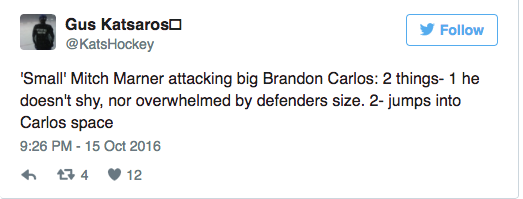Mitch Marner, the highly-touted prospect soon to graduate to full-blown NHLer, falls under hockey’s definition of “small” – even if he’s listed at six feet, 170 pounds.
The 19-year old has already dazzled Leafs fans and puck viewers with a brilliant preseason and start to the 2016-17 season, keeping fans on the edge of their seats with a unique blend of highlight reel skills and a high-octane engine.
Different factors contribute to player success, but smaller players seem to get the biased view of overcoming a size deficit. Intelligence — and not just hockey IQ — can make up for shortcomings, even if size is seen as one of them.
Smart players read plays quickly and efficiently, are proactive instead of reacting to the play or players, and contribute little, unnoticed plays on a shift-by-shift basis.
Example 1
Here’s an example.
Marner makes this play without even touching the puck. He recognizes the opportunity afforded by allowing the puck to get to his forehand, and executes a forward pass from the middle of the zone instead of contorting his body into a position to retrieve the puck. He then turns again to advance the play. It’s such a subtle little thing that smart players just instinctively know how to exploit.
That pass reception from Mitch Marner here.
Full control of the puck without touching it pic.twitter.com/c6HntogVra— Gus Katsaros🏒 (@KatsHockey) September 18, 2016
The play is oddly reminiscent of the no-touch pass Mario Lemieux let go between his legs during the 2002 Men’s Olympic Hockey gold medal game.
This is a great example of what really makes Marner such a fine prospect and how he defies the small stigma. The dazzle plays are striking, but — as a ‘smaller’ player –fearlessness and ability to manipulate bigger opponents will be the key.
Dominating physically isn’t a clear option, so it’s up to him to be smarter and use his unique situation to leverage any size deficiencies instead of playing to avoid physical engagement, with the result turning the tide in his favour.
Example 2
That's 'diminutive' Mitch Marner bravely streaking into a scoring area with speed to cut around a bigger, stringer player. https://t.co/iSrm0l8Cqi
— Gus Katsaros🏒 (@KatsHockey) October 7, 2016
Marner jumps right into Shea Weber’s space here while cutting across the middle of the ice, almost right in front of him with the risk of knowing the potential fallout if Weber engages physically. On this occasion, Weber got the better of the situation, but look at what Marner does.
By cutting across, Marner forces the defenseman to prepare for two possible outcomes: physical engagement and moving forward, or prepare to make the pivot — preferably without a crossover. A little more straight away speed on Marner, or if he was able to cut in closer to Weber (once again with speed) after passing right in front of him, and he’s forcing the reaction on the play to the bigger opponent.
Advantage Marner.
No longer is Weber in control of this situation. It’s all about how Marner plays it. Weber has to make the decision to engage physically, or monitor and react after Marner has made his move.
Example 3

Brandon Carlo is listed at 6-foot-5 and 203 pounds. The Bruins second round selection from the 2015 draft (37th overall) has five inches and 30 pounds on Marner. Maybe the latter should stay away from the former?
Not a chance.
He could have passed on the outside, avoided contact and taken a weak shot on net. Instead, he attacked Carlo’s space, getting close to his body while applying a burst of speed. Marner forced the defenseman into a crossover with speed, dropped his shoulder, and jumped right into his space. The desperation stick check made the play less dangerous – this time.
NHL defensemen, despite the size, will have to handle this kind of one-on-one for a long time. Taking the game to the bigger player and removing their leverage is the key to Marner’s success.
Forget the stigma of being small. It’s about smarts, and the application of a unique skillset, in order to overcome any size deficiency.

































